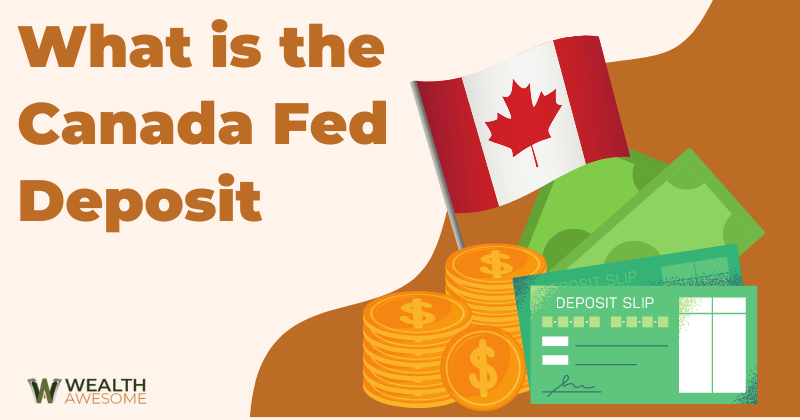Seeing an unexpected deposit in your bank account can be pretty confusing, especially if it seems like it may be from the government.
Is it a scam? Do you have to report it or give it back? What exactly is the Canada Fed Deposit?
Canada Fed Deposit is a payment from the federal government of Canada. It is issued by the Canada Revenue Agency, also known as the CRA, for a rebate, benefit or credit that you are eligible for as a Canadian citizen or permanent resident.
The deposit into your bank account is likely a part of one of the following programs:
- Canada Workers Benefit (CWB)
- Canada Child Benefit (CCB)
- Child Disability Benefit (CDB)
- Goods and Services Tax rebate (GST/HST)
Let’s get into the details of what the deposit may be, whether you will be taxed for it, how you can check its legitimacy and more!
The Canada Fed Deposit: The Details
As I mentioned, your Canada Fed Deposit is most likely part of a government program such as the Canada Workers Benefits, Canada Child Benefit, Child Disability Benefit or the GST/HST program for low to mid-income individuals and families.
These programs aim to redistribute wealth and increase welfare in Canada. For some of these programs, an application may not be required or necessary, which is why you might be surprised to see it on your bank statement out of the blue.
Let’s briefly touch on the four programs that constitute the Canada Fed Deposit.
1. Canada Workers Benefit (CWB)

This program is designed as a refundable tax credit for low-income earners in Canada.
You are eligible for this program if you earn a working income (less than $32,244), are a Canadian resident, and are over 19 years of age. Unfortunately, if you are a student, you are not eligible for this program.
The CWB has two different parts: a basic amount and a disability supplement. The maximum amount you can get for the “basic amount” is $1,395 for single individuals and $2,403 for families.
The maximum amount for the disability portion, on the other hand, is $720 for both single individuals and families.
You can claim this benefit when you file your annual income tax return.
2. Canada Child Benefit (CCB)

The CCB is a monthly tax-free payment made to qualified families to support the cost of raising children.
You can apply for the benefit if you are the primary caregiver for a child under the age of 18 (you must be living with them.) You must also be a Canadian citizen or a permanent resident.
You may also be eligible for this benefit if you hold shared custody of your child(ren).
Your eligibility amount will depend on the age of your child/children. For children under six, the maximum benefit amount is $6,833 per year or $569 per month.
If your kids are aged between six and 17, the maximum amount is $5,765 per year or $480 per month.
During the COVID-19 pandemic, there were additional payments made to families through the CCB program to support child care.
If you saw an expected payment during this time, it may be because of the extension of this program. You can read more about this extended support here.
3. Child Disability Benefit (CDB)

The child disability benefit (CDB) is a monthly tax-free payment made to families who care for a child under the age of 18 who has severe and prolonged impairment in mental or physical functions.
The amount you will receive will depend on the number of disabled dependants in a household, household income, and marital status.
The maximum monthly amount you can receive through the Canada Child Disability Benefit is approximately $240.
4. Goods and Services Tax Credit (GST/HST)

The Goods and Services Tax/Harmonized Sales Tax credit (GST/HST) is a tax-free benefit paid to low and mid-income individuals and families in Canada.
This payment is made out quarterly to those who are eligible, and it aims to offset the GST or HST that citizens pay in their everyday purchases.
It is not necessary to make an application for this credit, as you are automatically considered when you file your taxes.
Two things will affect how much you will get through this program: the line 23600 amount from your income tax return and whether you have a spouse or common-law partner.
Based on these numbers, you could get up to $456 each year if you are single, $598 if you have a spouse or a common-law partner and $157 for each dependant under the age of 19.
Why did I get a Canada Fed payment?
If you got a Canada Fed Payment, you were eligible for one of the four federal programs I just detailed.
The payment should have been deposited into the bank account that you have on file with the Canada Revenue Agency (CRA.)
If you have not signed up for direct deposit with the CRA, you will receive an official cheque in the mail from the government for your Canada Fed Payments.
However, I would really recommend signing up for direct deposit as it will be much quicker and safer to have access to your government funds.
It is also much more environmentally friendly as it does not have to be printed and shipped to you.
Checking the Legitimacy of Your Canada Fed Deposit

If you are unsure about the legitimacy of your Canada Fed Deposit, you can cross-reference it on your CRA My Account.
This digital application is a secure portal that allows you to view your personal income tax and benefit information while also managing your tax affairs from the convenience of your own home.
If something does not look right to you regarding your Canada Fed Deposit, you can contact the CRA.
If you’re wondering about payment dates so you can plan and budget accordingly, an extensive list of federal benefit payment dates can be found here.
How Canada Fed Deposits Impact the Economy
The Canada Fed Deposit program has had a significant impact on the economy, providing financial assistance to millions of Canadians.
Direct deposit payments help low to mid-income individuals and families who may be struggling financially. Additionally, Canada’s federal deposits played a vital role in supporting Canadians throughout the COVID-19 pandemic, offering direct deposits to those who were struggling to get by.
Overall, these financial assistance programs have helped stimulate the economy by putting money directly into the hands of consumers.
This, in turn, increases consumer spending (helping small businesses) and boosts the economy as a whole, even when times are tough.
These deposits have also helped reduce the burden on social services. By providing financial assistance to those in need, benefits such as the Canada Child Benefit and GST/HST credit have helped reduce the number of Canadians who require social services.

FAQs About The Canada Fed deposit
To wrap up, here are a few quick answers to some of the most commonly asked questions about deposits and credits issued by the federal government.
What is the amount of the Canada Fed deposit?
The amount of the Canada Fed deposit varies depending on the program you are eligible for.
The most common programs that result in Canada Fed deposits are the Canada Child Benefit (CCB), the Goods and Services Tax/Harmonized Sales Tax (GST/HST) credit, and the Canada Workers Benefit (CWB).
The amount you receive for each program is calculated based on various factors such as your income, family size, and province of residence.
Who is eligible for the Canada Fed deposit?
To be eligible for the Canada Fed deposit, you must be a Canadian citizen or permanent resident who meets the specific eligibility criteria for one or more of the programs that result in Canada Fed deposits. You can check your eligibility by contacting the CRA or Service Canada.
Why did I receive a Canada Fed deposit?
You received a Canada Fed deposit because you are eligible for one or more of the programs that result in Canada Fed deposits.
The deposit could be for a variety of reasons, such as a benefit, a tax refund, or a credit. If you are unsure why you received a Canada Fed deposit, you can check your CRA account or contact the CRA directly.
How do I confirm my Canada Federal deposit?
You can confirm your Canada Federal deposit by checking your bank account statement or by logging into your CRA My Account. Your CRA account will show you the details of your deposit, including the program it is for, the amount, and the date it was deposited.
Is the Canada Fed deposit taxable income?
The Canada Fed deposit is not taxable income. However, if you received a deposit for a program that is based on your income, such as the CCB or the CWB, you may need to include the amount in your income tax return.
Are there specific payment dates for Canada Fed deposits?
Yes, there are specific payment dates for Canada Fed deposits. The payment dates vary depending on the program you are eligible for.
For example, the CCB is usually paid on the 20th of each month, while the GST/HST credit is paid quarterly. You can check the payment dates for your specific program on the CRA website or by contacting them directly.
Conclusion

The Canada Fed Deposit is a payment from the federal government of Canada for one or more of the following welfare programs: the Canada Workers Benefit (CWB), the Canada Child Benefit (CCB), the Child Disability Benefit (CDB) and the Goods and Services Tax credit (GST/HST).
You can learn more about these payments, as well as your eligibility for them, on your CRA My Account.
Wondering about another federal deposit into your bank account? Read up on the Canada GSL Deposit, what it is, and whether you are eligible.





I am unable to understand the benefits of this issue?